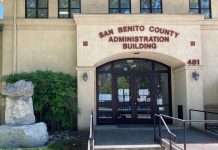It’s official: nearly 3,000 additional acres of wilderness land
in Pinnacles National Monument will never be developed.
President Bush has signed into law legislation by Rep. Sam Farr,
D-Carmel, designating 2,715 acres at the national monument in South
County as federally protected wilderness.
The law also included 51,758 acres of land along the Central
Coast as protected land, including 34,703 acres in the Ventana
Wilderness of the Los Padres National Forest.
It’s official: nearly 3,000 additional acres of wilderness land in Pinnacles National Monument will never be developed.
President Bush has signed into law legislation by Rep. Sam Farr, D-Carmel, designating 2,715 acres at the national monument in South County as federally protected wilderness.
The law also included 51,758 acres of land along the Central Coast as protected land, including 34,703 acres in the Ventana Wilderness of the Los Padres National Forest.
The law, known as the Big Sur Wilderness and Conservation Act of 2002, provides the land at Pinnacles federal protection and shields the area from any new development.
“One of the things the park does is preserve a part of old California,” said Cicely Muldoon, superintendent at Pinnacles National Monument. “It protected a good part of the inner coast ranges so that people can enjoy sweeping vistas of open space that will never be developed and it provides open habitats for all the critters people see in the park.”
The acreage was added to the park two years ago and was designated as a wilderness area of the park. The new law adds a wilderness overlay that protects the land further, Muldoon said.
Most of the newly protected land is in the Ventana Wilderness of the Los Padres National Forest. The remaining 20,000 acres are divided between the Silver Peak Wilderness, southwest of Fort Hunter-Liggett, and at Pinnacles National Monument.
“I am thrilled we’ve been able to expand the reach of nature in Monterey and San Benito counties,” Farr said. “This new wilderness designation … guarantees unspoiled beauty for the enjoyment of generations to come and ensures that the pristine wilderness lands in our region will stay open and wild.”
Part of law allocates $5 million for a five-year pilot program to help eradicate non-native and invasive plant species in the Big Sur region and help aid in the recovery of endangered animal species in the entire region, like the California Condor.
Pinnacles officials have been working for years to get condors to the park and are hoping to have some by next year, Muldoon said.
The Ventana Wilderness Society began construction of a new condor release site at Pinnacles in early November, according to the VWS.
The most recent expansion of protected lands at the Pinnacles occurred in 2000 when former President Bill Clinton designated an additional 7,960 acres.
Farr drafted legislation for that expansion as well. But Clinton issued a presidential proclamation to forego congressional red tape.
The new legislation is one portion of a larger bill. Democratic Sen. Barbara Boxer’s California Wild Heritage Wilderness Act of 2002 aims to add federally protected lands throughout the state. Farr credited Boxer for pushing his part of the act through the Senate.
Wilderness is defined by the Wilderness Act of 1964 as undeveloped land without permanent alterations or human habitation, which is managed to preserve natural conditions. Signed by former President Lyndon B. Johnson, it expanded the scope of park preservation and gave Congress the ability to designate specific park land as wilderness.
Wilderness land remains open to the public for hiking, horseback riding, camping, hunting, fishing, bird watching, rock climbing and other non-mechanized activities.
Former President Theodore Roosevelt established the Pinnacles National Monument in 1908. Rock formations can be found throughout the park, with the most scenic views on its High Peaks Trail.
The remains of ancient volcanos make up the park, which is part of the Gabilan Mountain Range.
The monument has previously expanded five times.
For information on the monument or visiting hours, call (831) 389-4485.








